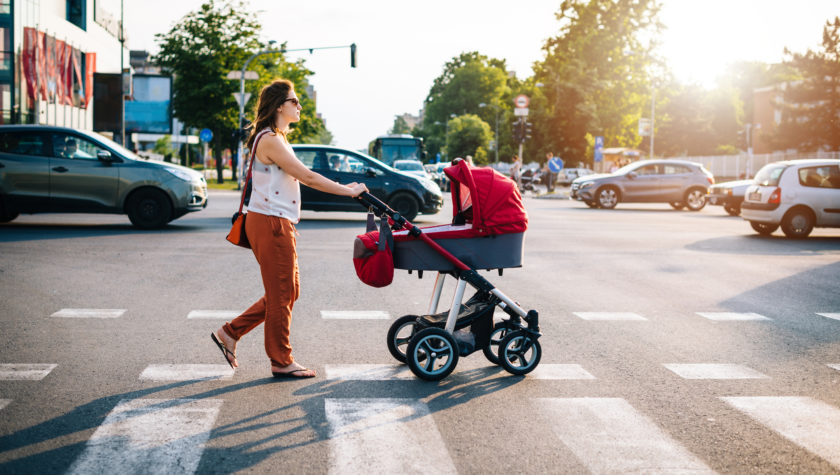The government has announced a £2bn package to create a new era for cycling and walking. It might be a response to the pandemic but the pledge is an important step towards putting people and the environment first.
Having advocated for recalibrating the “movement hierarchy” through the VeloCity project for the past three years (the winner of the Commission’s Oxford to Cambridge Growth Arc Ideas Competition), and not least as the parent of a pre-schooler affected by air pollution, I very much welcome the announcement.
In 2017, the Guardian released data showing that 802 primary and secondary schools in London are within 150 metres of nitrogen dioxide pollution levels that exceed the EU legal limit of 40µg/m. I was shocked to find that in our catchment area only one primary school is within the legal limit. After three years, more than a dozen hospital admissions and a cupboard stocked with inhalers, the invisible air around me has acquired a colour and a shape.
To make matters worse, just as we were enjoying the first shoots of spring blossom in the UK, we found ourselves overtaken by the Covid-19 pandemic which put people with underlying respiratory conditions at higher risk of more severe infection.
Vehicles contribute to 80% of air pollution breaches and 34% of greenhouse gas emissions. In their National Infrastructure Assessment, the National Infrastructure Commission is urging the government to speed up its preparations for electric and autonomous vehicles. London Mayor Sadiq Khan has been pushing ahead with a series of policies and measures including introduction of the ultra-low emissions zone in 2019 and improvements to cycling and walking infrastructure to combat London’s toxic air, which he dubbed a “shameful health crisis causing premature deaths and stunting the growth of children’s lungs.”
The unusual conditions imposed on us by the pandemic reveal more data supporting the need to think differently about how we move around in light of climate emergency. A recent study by the Centre for Research on Energy and Clean Air revealed that improvement in air quality during coronavirus lockdown across Europe resulted in 6,000 fewer children developing asthma, 1,900 avoiding emergency room visits and 600 fewer preterm births, along with significant reductions in deaths from pollution in the UK and Europe.
But it is not all about numbers. A recent poll published in the Guardian and endorsed by leading economists also shows that Britons want quality of life indicators to take priority over GDP measures even after the pandemic.
We have been witnessing increased awareness of mental health and a surge of interest in biophilic design and rewilding in cities. Co-working hubs like Second Home have embraced nature’s “tremendous benefits to our psychological wellbeing” and there have been campaigns to plant more trees to help meet net-zero carbon emissions and to improve biodiversity.
The adverse effects of air pollution along with the benefits of cycling and walking on our physical fitness and wellbeing should be an impetus to carry forward these fundamental changes in how we live and move around post-pandemic.
What we found through our VeloCity research is that the cultural shift away from cars requires investment into new networks and services to support cycling and walking for all ages and abilities, making it the easy and most convenient choice. For commuters, folding bikes and electric scooters make multi modal travel easy and convenient. Options for the school run include the bike bus and bikes with facilities to carry children and for last mile journeys adopting the use of electric buggies and electric vehicles is a good option, which can be used for local waste collection and deliveries.
One of the major issues to enable this paradigm shift is where and what kind of new housing is built. The BBC reported on research by Transport for New Homes which found that “young couples are trapped in car dependency”. This was echoed by the national audit conducted by UCL for CPRE, which found that most new housing is so poorly designed it should not have been built.
It does not take a crystal ball to see that air pollution is not a siloed issue and the type of environment we build – from housing through public spaces to infrastructure – will determine everything from air quality through to mental health and productivity.
Thinking holistically about nature and the built environment, we need to link housing and infrastructure to create connected places so that people can live near where they work or can easily reach it by sustainable transport. One legacy of coronavirus may be enduring home-based or flexible working.
Although housing itself is not within the Commission’s remit, we found the link between housing and infrastructure a critical piece of the puzzle. The Commission recognises this important link and has been pushing an integrated agenda on a number of fronts from the Partnering for Prosperity report, which sets the ambition for Cambridge – Milton Keynes – Oxford arc to reap the benefits of a fine grain placemaking approach to connect new infrastructure and housing across this fastest growing region in the UK; to the Cities Programme supporting city leaders, including Metro Mayors, to develop long-term strategies for improving transport links with new homes and work places.
The Building Better Building Beautiful Commission’s report, published in February, explored what makes a good place and set out the government’s ambition to make planning a positive process, “moving away from fear”. This will require skilled teams in local authorities to put design and placemaking at the heart of the process and to bring communities together to combat nimbyism. It also requires investment into a new way of life which centres on people’s wellbeing.
We can design the air we breathe – by considering carefully everything it touches.
Opinion piece by Petra Marko, Co-founder of Marko and Placemakers. A shorter version of this article was first published in Building Design on 14th May 2020.




